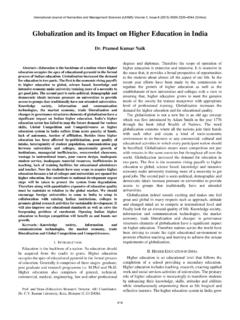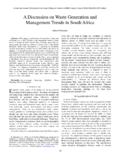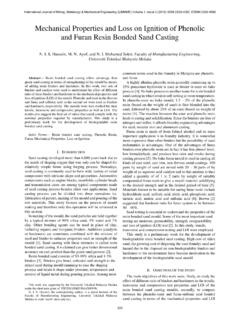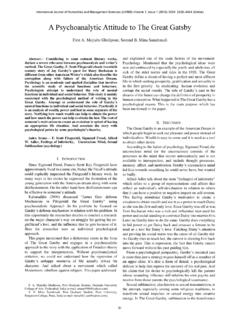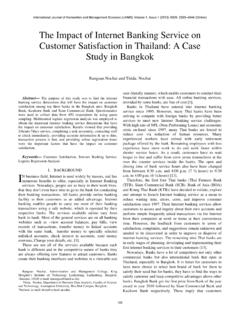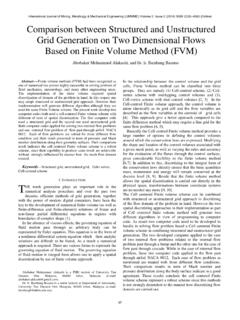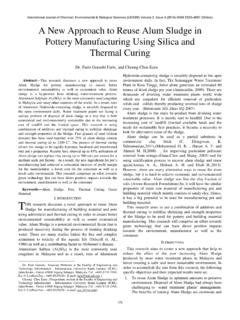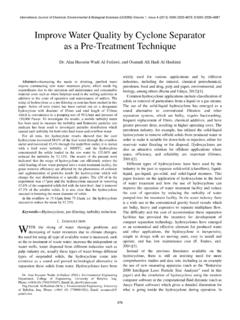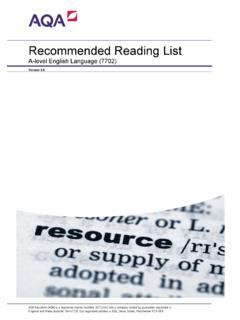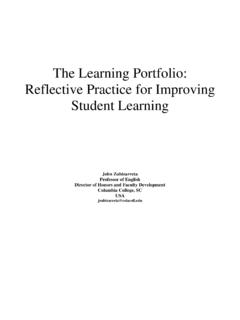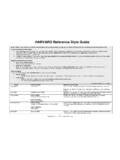Transcription of Challenges for Teaching English as a Second Language and ...
1 Abstract Teaching of any Second Language has always been an arduous task, specifically, while dealing with the students who come from different cultures and backgrounds as it involves some complexities which can be overcome through the application of appropriate strategies. This paper is meant to focus on the hurdles and barriers that the learners of a Second Language , particularly, of English , often encounter and the remedies that can help ride over these odds. Keywords Teaching English , Teaching methods, ESL standards, Challenges face learners. I. INTRODUCTION TUDENTS with English as a Second Language constitute a significant percentage of the population around our globe.
2 This population continues to increase more rapidly than that of native English speaking students (Shore, 2001), so Teaching of English is becoming of great significance. Every teacher who teaches any subject matter in English to ESL students is not only a teacher of the content area but also is a teacher of English as well so he/she should have to continually reflect on Teaching and update practice to address the needs of the learners. This paper includes an analysis of the Challenges ESL students face and the strategies that teachers can use to meet these Challenges . II. Challenges FACED BY LEARNERS OF ESL ON STRANGE LAND The major challenge that the learners of ESL experience is described as " Language shock," a struggle to learn the English Language to be absorbed in a society that is not willing to embrace diversity.
3 Such are the students, who on any strange land, try to maintain a sense of identity related to their native culture. Students encounter many obstacles in their efforts to become proficient in the English Language . They often come to realize that in order to be fully accepted, they must abandon their native Language , surrendering an aspect of their identity. They are caused to feel they must either speak English or nothing at all. Thus, they become trapped in a painful power struggle over the use of English and their native Language . Instructors must realize that education occurs in the context of a social climate. The relationships between students and accompanying range of social behaviors have a major impact on how well ESL students learn English .
4 Many learners fail to Sayeh Abdullah is with the College of Electronic Technology, Baniwalid, Libya (corresponding author to provide phone:+218-928065811; fax: +218(0)315243134; . adjust in an unwelcoming, hostile environment where they are made fun of when they try to speak English and also when they speak their native Language ; so they end up silent and withdraw from participation, thus their learning and achievement is hindered. While ESL students are taught academic English in separate classrooms they often lack the ability to interact in social settings with English speaking peers and often have limited opportunity to interact academically or socially.)
5 They often have great difficulty learning the "slang" and social English because they have no one to learn it from. Such learners come to prefer English out of necessity, often abandoning their native languages to fit in. They end up without comfort in either Language and may end up losing the ability to communicate with family members and friends in their native land. It can be concluded that ESL students will remain torn between two worlds until society truly embraces diversity and the notion that biculturalism and bilingualism are assets. What is needed in the education of ESL learners is the development of English and maintenance of their native Language .
6 III. BARRIERS TO MEANINGFUL INSTRUCTION FR English LEARNERS Here are mentioned some of the barriers and the effective measures that teachers can adapt to help the ESL students in overcoming the barriers to meaningful instruction. Teachers can use strategies based on social interactionist theory, such as that of Vygotsky, to create classroom conditions that foster learning by modeling, scaffolding and helping students to construct understanding, with the eventual goal of becoming independent thinkers and problem solvers. There are four loads that can be identified as barriers to meaningful instruction; cognitive load, culture load, Language load and learning load.
7 It is demanded that the English Language teachers must be skilled enough at lowering these barriers and sparking student interest and curiosity by developing a creative, wise and passionate curriculum. A. Cognitive Load It refers to the number of new concepts embedded in a lesson. It is critical that we consistently assess prior knowledge of all students to identify the concepts and skills they do and do not possess. We must then fill in any conceptual gaps by trying to relate new concepts to life experiences of ESL students. Thus, it becomes more critical to get to know and understand these students. Challenges for Teaching English as a Second Language and their Remedies Sayeh.
8 Abdullah S International Journal of Humanities and Management Sciences (IJHMS) Volume 3, Issue 6 (2015) ISSN 2320 4044 (Online) 371 B. Culture Load Culture load: It refers to the way Language and culture are related and the amount of cultural knowledge required to comprehend meaning or participate in an activity. Meanings of words are determined by the uses of words within linguistic and cultural settings, never the same in any two cultures. English learners need to learn the words in English as well as the cultural background that gives the words their English meaning. They need to learn words in context to understand the meaning. Additionally, the information conveyed in our textbooks and lessons is culturally embedded.
9 Some texts or topics can actually be culturally offensive. Culture load also refers to how teachers expect interaction to occur in a classroom that includes when to speak, when to stay silent, when to respond and when to write. These expectations vary from one culture to the next. English learners are often expected to determine the classroom behavioral norms independently. The following strategies can help teachers lighten the culture load for students. Teachers should treat English learners with respect, not judgment, and try to be friendly with students and try to establish social relationships with their elders. Teachers can use information gained through these relationships to develop lessons and activities that help students understand the teacher's culture.
10 By demonstrating respect for students, teachers allow a door of trust to open that can serve to further deepen a nurturing teacher-student relationship. C. Language Load It refers to the number of unfamiliar words encountered as an English learner reads a text or listens to teacher or peer academic talk. Teachers can lessen this load by rewriting or explaining text material. Complex sentences can be broken down into comprehensible parts. Academic vocabulary can be presented at the start of a lesson and highlighted. Several different texts can be available covering the same content but at different reading ability levels. Additionally, teachers should model both academic and social Language and scaffold its appropriate use to help the learner acquire it, use it effectively, and move to more sophisticated levels of speaking and writing D.

